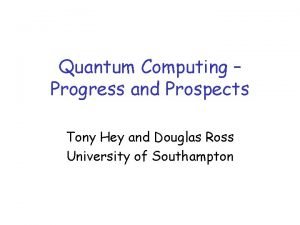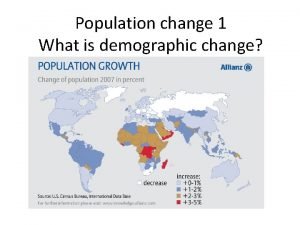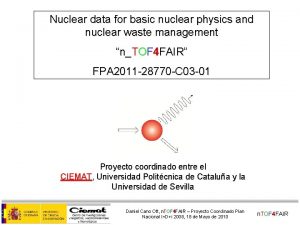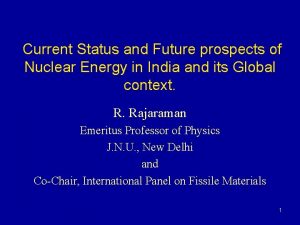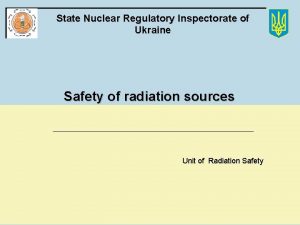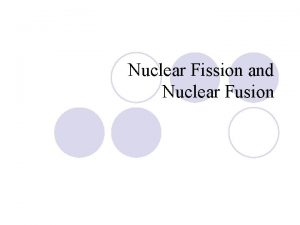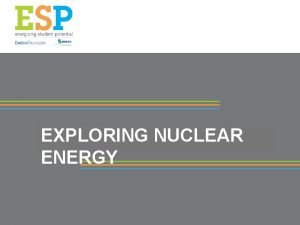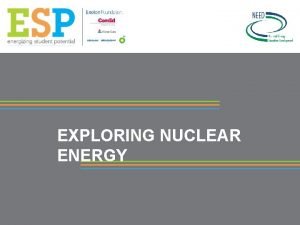State of Computational Nuclear Data and Future Prospects







- Slides: 7

State of Computational Nuclear Data and Future Prospects WANDA 2021 – Advanced Computing for Nuclear Data January 29, 2021 Dave Brown, Bethany Goldblum, Ben Loer, Matt Mumpower, Nicolas Schunck, Michael Smith LLNL-PRES-XXXXXX LLNL-PRESThis work was performed under the auspices of the U. S. Department of Energy by Lawrence Livermore 818720 National Laboratory under contract DE-AC 52 -07 NA 27344. Lawrence Livermore National Security, LLC

Computing in the Nuclear Data Pipeline Computing is ubiquitous in nuclear data – from models to uncertainty quantification and actual applications § Data analysis Application § Physics codes — Nuclear science — Evaluation — Transport/network Simulation Codes Measurement Uncertainty Propagation § Statistical analysis — Uncertainty quantification — Uncertainty propagation — Supervised/unsupervised Processing Theory learning Evaluation LLNL-PRES-818720 LLNL-PRES-xxxxxx 2

Computing Physics Models Basic and applied science have similar computational needs but very different constraints § Nuclear science models: structure, reaction, decay — Nuclear physics keeps improving and becoming more predictive: the physics behind the models and the codes changes! — The more fundamental and/or the more built-in physics, the more computationally expensive (usually) § Application models: transport, networks, etc. — Underlying physics rarely changes if at all — Challenges include increasing fidelity, addressing more complex/realistic designs, increasing throughput (e. g. , for UQ studies), etc. § High-performance computing and leadership-class supercomputers are often key to realistic, higher-fidelity simulations § Quantum computing may have potential to revolutionize computing Fully exploiting HPC techniques and facilities requires constant refactoring of codes, long-term maintenance, cross-cutting skills LLNL-PRES-xxxxxx LLNL-PRES-818720 3

Machine Learning and Artificial Intelligence ML/AI enables new physics and is enabled by HPC § Generic types of ML/AI applications — Physics-driven: learn about your model • Explore parameter space of physics model • Sensitivity analyses, uncertainty propagation, inference/inverse problem • Emulator of computationally expensive models/workflows with ML/AI tools — Data-driven: learn from your data • Identify correlations, detect patterns and features • Build statistical model of the data – For analysis (feature identification, pattern detection) – For predictions (generative models) § ML/AI can itself be computationally expensive and require HPC § Recent emergence of comprehensive open-source frameworks (Tensorflow, Pytorch, etc. ) is a game changer ML/AI can augment existing physics models by providing emulators and diagnostic tools, or unveil hidden patterns in data LLNL-PRES-818720 LLNL-PRES-xxxxxx 4

Goals We want to establish a prioritized list of computational capability needs/opportunities relevant to the nuclear data pipeline § General organization of the session — 2 hours of presentations on HPC, ML/AI and quantum computing — a welcome break — 1 hour of general discussion § Outline of each talk — Background and problem overview — Computational needs: HPC and/or ML/AI? — Specific techniques — Results / challenges § Speakers should address a list of overarching questions in their talk § General discussion is key to collectively agree on priorities: inputs from the audience is not just welcome but needed LLNL-PRES-818720 LLNL-PRES-xxxxxx 5

Agenda § Reminder: List of Speakers — High-Fidelity Simulations with HPC – Moderator: Matt Mumpower • • Kostas Kravvaris, Predictive theory for light-ion reactions Ionel Stetcu, HPC for fission modeling in support of nuclear data Trevor Sprouse, Propagation of nuclear model uncertainties in science application Paul Romano, Perspectives from the Exa. SMR Project: Nuclear Data Needs and Opportunities — AI/ML Enabling Capabilities – Moderator: Dave Brown • • Georg Schnabel, Containerization and microservices for nuclear data Mateusz Ploszkon, Selected topics from physics-aware ML Walid Younes, Natural Language Processing for Nuclear Science Scholarship Christian Brazel, Surrogate Modeling for Fission Cross Sections and Criticality Studies using Artificial Neural Networks — Quantum Computing – Moderator: Ben Loer • Kyle Wendt, Quantum Computing: A cold bright future for nuclear theory and nuclear data § Discussion – Moderator: Bethany Goldblum — What are the capability needs and opportunities for advanced computing in the nuclear data pipeline? — How do they map to impact applications (i. e. , different priorities for different sponsors)? — What is the time horizon for capabilities? How does this impact priorities and actionable tasks? — How good do these new tools need to be? Fidelity vs. impact. vs. difficulty, etc. LLNL-PRES-818720 LLNL-PRES-xxxxxx 6

Disclaimer This document was prepared as an account of work sponsored by an agency of the United States government. Neither the United States government nor Lawrence Livermore National Security, LLC, nor any of their employees makes any warranty, expressed or implied, or assumes any legal liability or responsibility for the accuracy, completeness, or usefulness of any information, apparatus, product, or process disclosed, or represents that its use would not infringe privately owned rights. Reference herein to any specific commercial product, process, or service by trade name, trademark, manufacturer, or otherwise does not necessarily constitute or imply its endorsement, recommendation, or favoring by the United States government or Lawrence Livermore National Security, LLC. The views and opinions of authors expressed herein do not necessarily state or reflect those of the United States government or Lawrence Livermore National Security, LLC, and shall not be used for advertising or product endorsement purposes.


